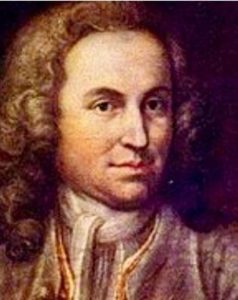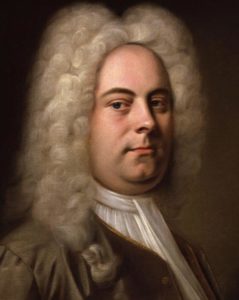Programme
Antonio Vivaldi (1678 – 1741)
Nisi dominus RV 608
Motet d’après le psaume 127 « Si le Seigneur ne construit la maison »
Georg Friedrich Haendel (1685 – 1759)
Silete venti HWV 242
Motet latin
Vivaldi, Haendel… L’un, profondément italien, est chevillé à sa ville, la Venise du XVIIIe s., celle de Goldoni appréciée pour ses maisons de jeux et ses théâtres, mais où l’art de bien chanter est descendu dans la rue. L’autre, le saxon, le germanique qui ne fait jamais de concession, mais partit pour l’Angleterre, y devint célèbre et le plus international des musiciens de sa génération.
Pourtant rien ne les oppose, car tous deux, en hommes de théâtre, ont su parfaitement comment conquérir un public, avec brio, sans frontière sensible entre les styles religieux et profanes.
Le Nisi Dominus de Vivaldi possède de nombreux atouts, son contenu poétique en particulier qui lui dicte d’une part le découpage de cette œuvre en six versets auxquels s’ajoute une doxologie tripartite (Gloria Patri, Sicut era in principio et l’Amen final) et d’autre part, une musique pour laquelle il choisit toujours le précédé qui lui donne le plus de force expressive. Un mot peut soudain la lancer dans quelque irrésistible vertige musical, aux sonorités insolites. L’accompagnement instrumental si systématique qu’il peut aller jusqu’à l’ostinato (verset IV cum dederit) contraste avec la ligne très libre et très fluide de la voix. Partout voix et cordes se répondent ou cheminent ensemble, dans le plus pur style concertant. Toute la force de séduction de ce psaume repose sur l’art des contrastes, l’alternance des rythmes lents et rapides, les changements brutaux d’atmosphère.
Haendel quant à lui manifeste dans Silete venti ce goût de la phrase pleine qui emporte chanteur et auditeurs dans la même respiration. Ce talent il le doit aux italiens. Ce motet d’origine inconnue a peut-être été écrit en 1707, lors du séjour qu’il fit entre Venise et Rome. Mais sa sinfonia d’ouverture, débute comme un opéra baroque français en mouvement lent de rythme pointé, suivi d’un pittoresque tourbillon des vents auquel la voix met brutalement fin (Silete – taisez-vous). Récits et airs de style concertant alternent ensuite. Haendel sort ici du chemin de la piété luthérienne qu’il dépasse dans un dialogue direct avec le Christ (suave Cher Jesus) puis dans la contemplation et la joie. Sensualité empruntée à l’opéra et triomphalisme, l’éloignent encore du milieu ecclésiastique. Puis, conformément à une tradition qui remonte au chant grégorien l’Alleluia final se perd dans de vastes vocalises jubilatoires.
Program
Antonio Vivaldi (1678 – 1741)
Nisi dominus RV 608
Motet from Psalm 127 « Unless the Lord builds the house »
Georg Friedrich Handel (1685 – 1759)
Silete venti HWV 242
Latin motet
Vivaldi, Handel… The one, deeply Italian, is rooted in his city, the Venice of the 18th century, that of Goldoni appreciated for its gaming houses and its theaters, and where the art of singing has taken to the street. The other, the Saxon, the Germanic never made any concessions, and left for England, became famous there and the most international musician of his generation. However, nothing opposes them, because both, talented for the theater, knew perfectly how to conquer an audience, brilliantly, without any sensitive border between religious and secular styles. Vivaldi’s Nisi Dominus has many advantages. Its poetic content dictates to the composer, first its division into six verses to which is added a tripartite doxology (Gloria Patri, Sicut era in principio and the Amen final ) and secondly, for his music a choice of many procedure which give her the most expressive force. A word can suddenly launch her into some irresistible musical dizziness, with unusual sounds. The instrumental accompaniment so systematic that it can goes as far as ostinato (verse IV cum dederit) contrasts with the very free and very fluid line of the voice. Everywhere voices and strings respond to each other or walk together, in the purest concertante style. All the seductive force of this psalm comes from the art of contrasts, the alternation of slow and fast rhythms, brutal changes of atmosphere.
Handel, for his part, manifests in Silete Venti this taste for the full sentence which carries singer and listeners in the same breath. He owes this talent to the Italians. This unknown origin motet may have been written in 1707, during Handel is moving between Venice and Rome. But its overture sinfonia begins as French Baroque opera with a slow and sharp rhythm, followed by a picturesque whirlwind of wind instruments abruptly interrupted by the voice (Silete ! – shut up). Then alternate recitative and concertante style arias. Handel here goes out of the path of Lutheran piety. He is beyond it, in a direct dialogue with Christ ( Dear Jesus) then in contemplation and joy. Sensuality borrowed from opera some triumphalism again distance him from the ecclesiastical circle. Then, in accordance with a tradition which dates back to Gregorian chant, the final Alleluia ends in a vast jubilant vocalizations.

